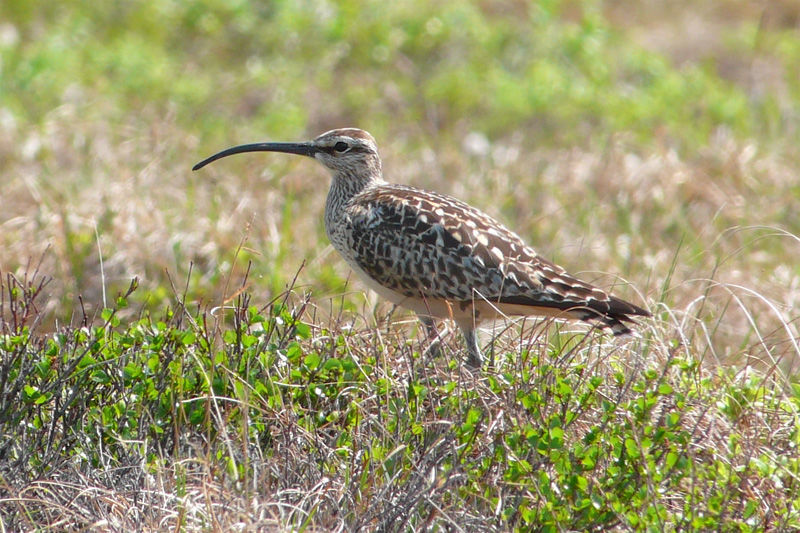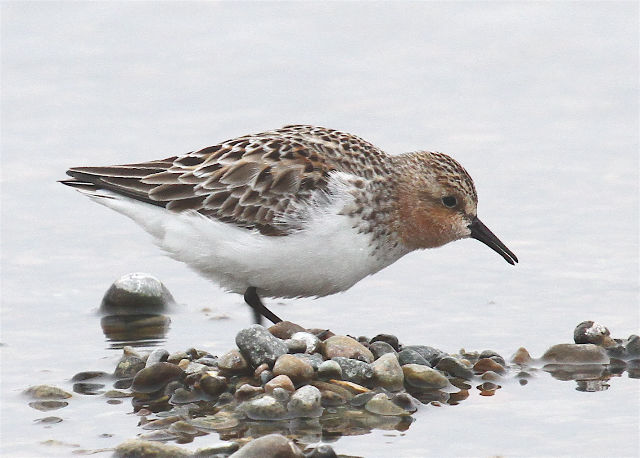Toll Free: 800.328.8368
Phone: 512.328.5221
Grand Alaska: Gambell and Nome
Upcoming Dates
June 2 - 12, 2025
Departs
Anchorage
Returns
Anchorage
Tour Limit
Online booking not available
Itinerary
Read More
Bristle-thighed Curlew © Barry Zimmer
Exciting birding for Bering Sea specialties and Siberian vagrants at two of western Alaska’s outposts. Witness spectacular daily movements of seabirds, along with excellent chances of Asiatic vagrants at Gambell. Breeding Bluethroats, Northern Wheatear, Eastern Yellow Wagtail, Rock and Willow ptarmigan, Bristle-thighed Curlew, Aleutian Tern, Gyrfalcon, and others, with Muskox, Grizzly, and Moose all possible at Nome.
When spring arrives on the shores of Alaska and Siberia, and thousands of birds rush northward to claim nesting territories, some of these small navigators make big mistakes. Every year a number of Asian migrants end up on North American soil. Birders have learned that they can intercept some of these strays by positioning themselves at strategic points in western Alaska. The Yup’ik village of Gambell, located at the northwest tip of St. Lawrence Island, and Nome, situated where Norton Sound meets the Seward Peninsula, are two such strategic points.
Gambell birding can be quite fabulous; remarkable strays that have occurred here include White-tailed Eagle, Black-tailed Gull, Oriental Pratincole, Green Sandpiper, Jack Snipe, Taiga Flycatcher, Stonechat, Siberian Rubythroat, Dusky Thrush, Eurasian Bullfinch, and many others. Our 2012 tour discovered and documented a Siberian Chiffchaff, a first confirmed record for North America! Our 1989 tour discovered a Little Curlew here—a first record for Alaska and only the third ever for North America—and our 1995 tour found a Tree Pipit, only the second ever for North America. Regular here are Common Ringed Plover, Red-necked Stint, White Wagtail, and Red-throated Pipit. Even on days when no vagrants show up, the birding is exceptional. Tens of thousands of murres, puffins, and auklets that nest east of the village are constantly moving just offshore, as are smaller flocks of loons, eiders, and Harlequin Ducks. Migrants passing the point often include Arctic, Pacific, and Yellow-billed loons, Emperor Goose, and Ross’s Gull (seen each of the past two years) and Ivory Gull (now quite rare, but seen in 2024).
After leaving Gambell, we’ll enjoy two-and-a-half days of exciting birding out of Nome, where our time will be spent looking for the many breeding specialties of the area, such as Arctic Loon, Bristle-thighed Curlew, Bar-tailed Godwit, Rock and Willow ptarmigan, Aleutian Tern, Gyrfalcon, Bluethroat, Northern Wheatear, Eastern Yellow Wagtail, and others. Nome also offers a diverse assemblage of more familiar North American species, but in unfamiliar, more colorful, breeding plumages, and in very different settings than those occupied on their wintering grounds, where most birders are used to seeing them—think Surfbirds amid alpine flowers; Wandering Tattlers, Harlequin Ducks and Arctic Terns along rushing rivers; Red-throated and Pacific loons and Black Scoters yodeling from tundra ponds; or male Lapland Longspurs and Wilson’s Snipe singing from atop road signs or even telephone wires! Although the chances of Asiatic vagrants turning up at Nome are somewhat less than at Gambell, it should also be noted that our past groups have often been treated to one or more Asiatic surprises. Nome also offers exciting mammals, with Muskox, Grizzly, and Moose all regularly seen.
Gambell & Nome may be taken alone or in combination with the Utqiagvik Extension for participants desiring a more comprehensive immersion into the tundra regions of western and northern Alaska.
Generally cold climate (temperatures usually 25–40 degrees Fahrenheit at Gambell, and 30–50 degrees Fahrenheit at Nome). At Gambell, simple accommodations with shared bathrooms; lots of hiking (some of it through loose gravel but on flat terrain —as of 2011, a network of hard-packed gravel roads through the village makes hiking to birding sites much faster and easier than in the past); ATV rides to and from birding sites are readily available and are easily arranged on a pay-as-you-go basis at each participant’s discretion for shorter excursions where others (including the leaders) may elect to walk (this option is much more flexible and less expensive for participants than including daily ATV rental in the cost of the tour); longer excursions (e.g. to the far end of Troutman Lake and beyond) or chases of vagrants (when time is of the essence) may require the entire group to ride in ATV-drawn carts, and the cost of these will be covered by VENT. Although the accommodations may be simple, the meals at Gambell are truly exceptional, outfitted and prepared by Chef Sean, whose culinary work has wowed our groups for the past four years. At Nome, good accommodations; most birding in-and-out of vans and along lightly-traveled gravel roads, with short hikes onto tundra; one optional long hike over difficult terrain for Bristle-thighed Curlew; long birding days, with optional late evening birding in this land of nearly 24-hour daylight.

Red-necked Stint © Kevin Zimmer
Price: $9,695
$200 off when combined with Barrow extension - call office for details
(Internal Flights Included)
Please contact the VENT office to register for this special departure.
Departure Dates
Route Map
Tour Leaders
Field Reports
No Field Reports
Connecting Tours
Operations Manager

Erik
Lindqvist
Questions? Contact the Operations Manager or call 800.328.8368 or 512.328.5221



